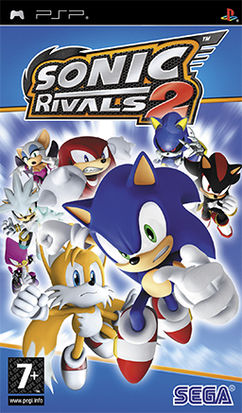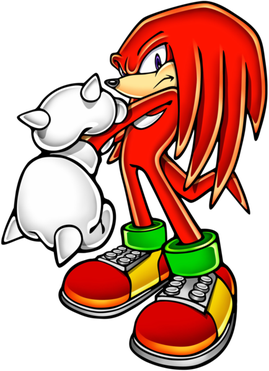
Knuckles the Echidna is a character from Sega's Sonic the Hedgehog series. He is a red anthropomorphic short-beaked echidna who is Sonic's secondary best friend and former rival. Determined and serious, but sometimes gullible, he fights his enemies using brute strength. He serves as the guardian of the Master Emerald, a huge gemstone that controls the series' integral Chaos Emeralds, and is the last living member of his tribe, the Knuckles Clan.

Sonic Heroes is a 2003 platform game developed by Sonic Team USA and published by Sega as part of the Sonic the Hedgehog series. The player races a team of series characters through levels to amass rings, defeat robots, and collect the seven Chaos Emeralds needed to defeat Doctor Eggman. Within each level, the player switches between the team's three characters, who each have unique abilities, to overcome obstacles. Sonic Heroes abandons the action-adventure and exploration-based gameplay of its predecessors Sonic Adventure (1998) and Sonic Adventure 2 (2001) and instead returns to the linear style of Sega Genesis-era Sonic games.

Miles Prower, better known by his nickname Tails, is a character from Sega's Sonic the Hedgehog series. Tails also appears in several spin-off games in which he stars, comic books, cartoons, and films. He is the second character to consistently appear by Sonic's side in the series as his best friend, appearing in nearly every mainline and spin-off since his debut. The name "Miles Prower" is a pun on "miles per hour", a reference to the famed speed of Sonic the Hedgehog. Miles Prower is a two-tailed fox, hence the nickname.
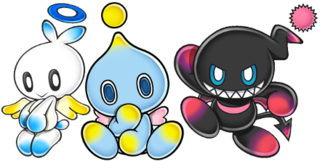
Chao are fictional life-forms in the Sonic the Hedgehog video game series published by Sega. They are small, childlike creatures that go through a complex life cycle and exist in several visual forms depending on how they are raised. Developer Sonic Team incorporated Chao into the games to encourage players to explore levels and support the good–evil dichotomy of Sonic Adventure 2.

Sonic Adventure 2 is a 2001 platform game developed by Sonic Team USA and published by Sega for the Dreamcast. It features two good-vs-evil stories: Sonic the Hedgehog, Tails, and Knuckles the Echidna attempt to save the world, while Shadow the Hedgehog, Doctor Eggman, and Rouge the Bat attempt to conquer it. The stories are divided into three gameplay styles: fast-paced platforming for Sonic and Shadow, multidirectional shooting for Tails and Eggman, and action-adventure exploration for Knuckles and Rouge.

Sonic X is a Japanese anime television series based on Sega's Sonic the Hedgehog video game series. Produced by TMS Entertainment under partnership with Sega and Sonic Team, and directed by Hajime Kamegaki, Sonic X initially ran for 52 episodes, broadcasting on TV Tokyo from April 2003 to March 2004. A further 26 episodes aired in North America, Europe, and the Middle East from 2005 to 2006. The American localization and broadcasting were handled by 4Kids Entertainment, which edited it and created new music.

Sonic Advance is a 2001 platform game developed by Dimps for the Game Boy Advance (GBA). It was the first Sonic the Hedgehog game released on a Nintendo console with Sonic Adventure 2: Battle on the GameCube, and was produced in commemoration of the series' tenth anniversary. The story follows Sonic, Tails, Knuckles, and Amy as they journey to stop Doctor Eggman from taking over the world. Controlling a character, players are tasked with completing each level, defeating Eggman and his robot army, and collecting the seven Chaos Emeralds.
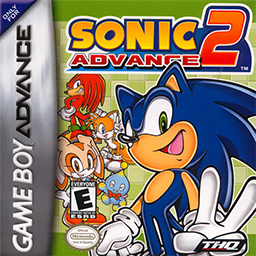
Sonic Advance 2 is a 2002 side-scrolling platform video game developed by Dimps for the Game Boy Advance. It is an installment in the Sonic the Hedgehog series and the sequel to 2001's Sonic Advance. The story follows Sonic as he sets out to save his friends and retrieve the seven magical Chaos Emeralds from Dr. Eggman. Gameplay consists of the player completing various levels as one of five characters, each with their own unique attributes. After each zone is completed, the player faces Dr. Eggman in a boss battle.

Sonic Battle is a 2003 fighting video game developed by Sonic Team for the Game Boy Advance. It is the second fighting game in the Sonic the Hedgehog series, the first game being Sonic the Fighters. It was released in Japan in December 2003 and in North America and Europe in early 2004. The game received a lukewarm response from critics.
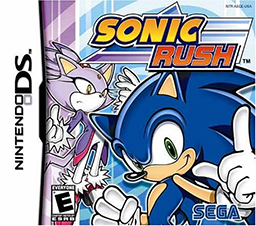
Sonic Rush is a 2005 platform game developed by Sonic Team and Dimps for the Nintendo DS as part of Sega's Sonic the Hedgehog series. It was released on November 15, 2005, in North America, November 18 in the PAL region, and November 23 in Japan, and was the final game in the mainline Sonic series to be produced by Yuji Naka before his departure from Sega. It is a 2D platform game, similar to earlier games in the series like Sonic Advance, as well as later ones like Sonic Mania. Levels in the game are side-scrolling and displayed using both of the DS's screens. However, boss battles, the main characters, and a special stage are rendered in 3D, creating a 2.5D effect. The game's storyline follows the intertwining adventures of the series' main character, Sonic the Hedgehog and a new character, Blaze the Cat. They respectively battle Doctor Eggman and his doppelgänger Eggman Nega at certain points.

Shadow the Hedgehog is a 2005 platform game developed by Sega Studios USA and published by Sega as part of the Sonic the Hedgehog series. The game follows Shadow the Hedgehog, a creation of Doctor Eggman's grandfather, as he attempts to learn about his past while suffering from amnesia. Shadow the Hedgehog reintroduces third-person shooter elements from Sonic Adventure and Sonic Adventure 2, but greatly expands upon the concept and introduces nonlinear gameplay to the Sonic franchise. To defeat enemies and progress through the game, Shadow can use a variety of weapons from each faction and complete missions that will determine the game's plot and subsequently playable levels.

Sonic Advance 3 is a platform video game developed by Dimps and Sonic Team for the Game Boy Advance in 2004. It is part of the Sonic the Hedgehog series, and the sequel to Sonic Advance 2. The game stars the characters Sonic, Tails, Knuckles, Amy, and Cream as they seek to keep Doctor Eggman and his robot assistant Gemerl from building empires on each of seven chunks Eggman has divided the Earth into.
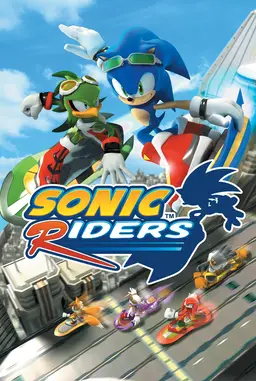
Sonic Riders is a 2006 racing video game for the GameCube, PlayStation 2, and Xbox in which the player controls characters from the Sonic the Hedgehog series on hoverboards. In the game's 16 tracks, the player competes against characters—either controlled by computers or other players—in story and battle modes. It was developed by Sonic Team and Now Production, published by Sega, and released in February 2006 in Japan and North America. It was released in Europe the following month and for Windows at the end of the year. A Game Boy Advance version developed by Backbone Entertainment was canceled.
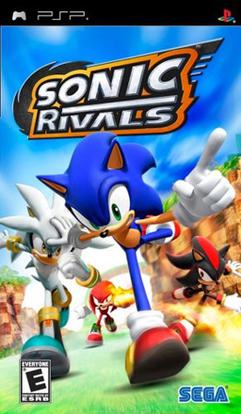
Sonic Rivals is a 2006 action-racing video game developed by Backbone Entertainment and Sega Studio USA, and published by Sega for the PlayStation Portable (PSP); it is a game in the Sonic the Hedgehog series, and follows the heroes needing to stop Doctor Eggman Nega from turning everyone and the world into cards. The gameplay involves racing against other characters to get to the goal before them, as well as defeating the boss before the opponent does.
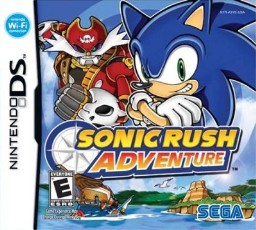
Sonic Rush Adventure is a 2007 platform game developed by Dimps and Sonic Team and published by Sega for the Nintendo DS. The sequel to 2005's Sonic Rush, it follows Sonic the Hedgehog and Tails, who are teleported to an alternate dimension and seek the help of Blaze the Cat, while battling a band of robot pirates. Gameplay is similar to prior installments in the Sonic the Hedgehog franchise, with players controlling Sonic or Blaze through a series of side-scrolling levels while collecting rings and defeating enemies. Sonic Rush Adventure deviates from prior games with its elements of sea travel, featuring boating minigames that take advantage of the DS's touchscreen.

Doctor Ivo "Eggman" Robotnik is the main antagonist of Sega's Sonic the Hedgehog franchise. Eggman was created and designed by Naoto Ohshima as part of many design choices for Sega's new mascot. After the creation of Sonic the Hedgehog, Ohshima chose to use his previous egg-shaped character to create the antagonist of the 1991 video game Sonic the Hedgehog, making him the arch-nemesis of the series' eponymous main character.

Sonic Mania is a 2017 platform game published by Sega for Nintendo Switch, PlayStation 4, Xbox One, and Windows. Produced in commemoration of the Sonic the Hedgehog series' 25th anniversary, Sonic Mania pays homage to the original Sega Genesis Sonic games, featuring speedy side-scrolling gameplay. It takes place over 13 levels, including several redesigned from past games. The story follows Sonic, Tails and Knuckles as they venture to defeat their nemesis Doctor Eggman and his robotic henchmen, the Hard-Boiled Heavies.

Sonic Forces is a 2017 platform game developed by Sonic Team and published by Sega. It was produced in commemoration of the 25th anniversary of the Sonic the Hedgehog franchise. Sonic the Hedgehog joins a resistance force alongside Classic Sonic, his past self, and the Rookie, a survivor of Eggman's attacks. Together they must stop Doctor Eggman, who has conquered most of the world alongside Infinite, a new enemy, who wields the power of the Phantom Ruby, and is able to create limitless numbers of illusionary clones of past villains. It features three gameplay modes: "Classic", side-scrolling gameplay similar to the original Sega Genesis Sonic games; "Modern", 3D gameplay similar to Sonic Unleashed (2008) and Sonic Colors (2010); and a mode featuring the "Avatar", the player's custom character.

The Murder of Sonic the Hedgehog is a 2023 point-and-click visual novel video game developed by Sega Social Team and published by Sega for macOS and Windows via Steam. The player converses with various Sonic the Hedgehog characters to investigate Sonic's apparent murder on Amy Rose's birthday. The game was released as freeware on March 31, 2023, to coincide with April Fools' Day, and was positively received.
